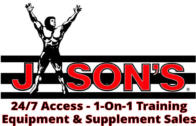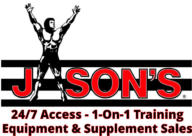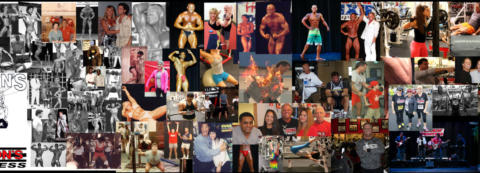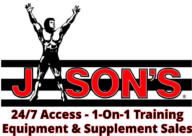www.jasonsfitness.com
Jason’s Fitness 3724 Cottage Hill Rd. Mobile, Alabama (251) 661-4615



Ankle flexors produce peak torque at longer muscle lengths after whole-body vibration.
Kemertzis MA, Lythgo ND, Morgan DL, Galea MP.
Rehabilitation Sciences Research Centre, University of Melbourne, Parkville, Victoria, Australia.
Erratum in: Med Sci Sports Exerc. 2009 Feb;41(2):482.
INTRODUCTION:
Whole-body
vibration
(WBV)
has
become
a
popular
training
method
in
recent
years.
This
study
investigated
the
effect
of
WBV
on
the
length-tension
relationship
of
the
ankle
dorsi-
and
plantarflexors
as
measured
by
a
Biodex
dynamometer
(Biodex
Medical
Systems
Inc,
Shirley,
NY).
METHODS:
Twenty
healthy
young
adult
males
participated
in
this
study
and
were
exposed
to
two
treatments.
The
first
treatment
(nonvibration)
involved
passive
stretching
of
the
plantarflexors
at
end
range
of
motion
(ROM)
for
five
1-min
bouts.
The
second
treatment
involved
the
same
passive
stretch
with
superimposed
WBV
(frequency
=
26
Hz)
for
five
1-min
bouts
on
a
rotary
vibration
plate
(Galileo
900;
Novotec,
Pforzheim,
Germany).
Voluntary
ROM,
peak
torque,
and
corresponding
joint
angle
of
the
plantar-
and
dorsiflexors
were
recorded
pre-
and
posttreatment.
Within-treatment
(before
and
after)
and
between-treatment
(WBV
and
nonvibration)
outcomes
were
assessed
by
repeated-measures
MANOVA.
RESULTS:
No
significant
changes
in
the
measures
of
ankle
dorsiflexion
were
found
within
or
between
treatments.
No
significant
changes
in
the
measures
of
ankle
plantarflexion
were
found
after
the
nonvibration
treatment.
After
WBV,
however,
there
was
a
significant
7.1
degree
shift
in
the
angle
(P
=
0.001)
of
peak
plantarflexor
torque
production
corresponding
to
a
longer
muscle
length.
CONCLUSION:
This
study
shows
that
stretched
human
ankle
plantarflexors
respond
to
WBV
by
generating
peak
voluntary
torque
at
longer
muscle
lengths.
T
his
has
possible
benefits
for
the
rehabilitation
of
patients
with
neuromuscular
disorders
(e.g.,
str
oke) who experience short ankle flexor resting lengths.

Everything you need to look and feel your very best!
24-Hour Access, 1-on-1 Personal Training,
Home Fitness Equipment & Supplement Sales.
Jason’s Fitness 3724 Cottage Hill Rd. Mobile, Alabama (251) 661-4615



Ankle
flexors
produce
peak
torque
at
longer
muscle
lengths
after
whole-body vibration.
Kemertzis MA, Lythgo ND, Morgan DL, Galea MP.
Rehabilitation Sciences Research Centre, University of Melbourne, Parkville, Victoria, Australia.
Erratum in: Med Sci Sports Exerc. 2009 Feb;41(2):482.
INTRODUCTION:
Whole-body
vibration
(WBV)
has
become
a
popular
training
method
in
recent
years.
This
study
investigated
the
effect
of
WBV
on
the
length-tension
relationship
of
the
ankle
dorsi-
and
plantarflexors
as
measured
by
a
Biodex
dynamometer
(Biodex
Medical
Systems
Inc,
Shirley,
NY).
METHODS:
Twenty
healthy
young
adult
males
participated
in
this
study
and
were
exposed
to
two
treatments.
The
first
treatment
(nonvibration)
involved
passive
stretching
of
the
plantarflexors
at
end
range
of
motion
(ROM)
for
five
1-min
bouts.
The
second
treatment
involved
the
same
passive
stretch
with
superimposed
WBV
(frequency
=
26
Hz)
for
five
1-min
bouts
on
a
rotary
vibration
plate
(Galileo
900;
Novotec,
Pforzheim,
Germany).
Voluntary
ROM,
peak
torque,
and
corresponding
joint
angle
of
the
plantar-
and
dorsiflexors
were
recorded
pre-
and
posttreatment.
Within-treatment
(before
and
after)
and
between-treatment
(WBV
and
nonvibration)
outcomes
were
assessed
by
repeated-measures
MANOVA.
RESULTS:
No
significant
changes
in
the
measures
of
ankle
dorsiflexion
were
found
within
or
between
treatments.
No
significant
changes
in
the
measures
of
ankle
plantarflexion
were
found
after
the
nonvibration
treatment.
After
WBV,
however,
there
was
a
significant
7.1
degree
shift
in
the
angle
(P
=
0.001)
of peak plantarflexor torque production corresponding to a longer muscle length.
CONCLUSION:
This
study
shows
that
stretched
human
ankle
plantarflexors
respond
to
WBV
by
generating
peak
voluntary
torque
at
longer
muscle
lengths.
T
his
has
possible
benefits
for
the
rehabilitation
of
patients
with
neuromuscular
disorders (e.g.,
str
oke) who experience short ankle flexor resting lengths.


Everything you need to look and feel your very best!
24-Hour Access, 1-on-1 Personal Training,
Home Fitness Equipment & Supplement Sales.
Jason’s Fitness 3724 Cottage Hill Rd. Mobile, Alabama (251) 661-4615



Ankle
flexors
produce
peak
torque
at
longer
muscle lengths after whole-body vibration.
Kemertzis MA, Lythgo ND, Morgan DL, Galea MP.
Rehabilitation
Sciences
Research
Centre,
University
of
Melbourne,
Parkville, Victoria, Australia.
Erratum in: Med Sci Sports Exerc. 2009 Feb;41(2):482.
INTRODUCTION:
Whole-body
vibration
(WBV)
has
become
a
popular
training
method
in
recent
years.
This
study
investigated
the
effect
of
WBV
on
the
length-tension
relationship
of
the
ankle
dorsi-
and
plantarflexors
as
measured
by
a
Biodex
dynamometer
(Biodex
Medical
Systems
Inc,
Shirley,
NY).
METHODS:
Twenty
healthy
young
adult
males
participated
in
this
study
and
were
exposed
to
two
treatments.
The
first
treatment
(nonvibration)
involved
passive
stretching
of
the
plantarflexors
at
end
range
of
motion
(ROM)
for
five
1-min
bouts.
The
second
treatment
involved
the
same
passive
stretch
with
superimposed
WBV
(frequency
=
26
Hz)
for
five
1-min
bouts
on
a
rotary
vibration
plate
(Galileo
900;
Novotec,
Pforzheim,
Germany).
Voluntary
ROM,
peak
torque,
and
corresponding
joint
angle
of
the
plantar-
and
dorsiflexors
were
recorded
pre-
and
posttreatment.
Within-
treatment
(before
and
after)
and
between-treatment
(WBV
and
nonvibration)
outcomes
were
assessed
by
repeated-measures
MANOVA.
RESULTS:
No
significant
changes
in
the
measures
of
ankle
dorsiflexion
were
found
within
or
between
treatments.
No
significant
changes
in
the
measures
of
ankle
plantarflexion
were
found
after
the
nonvibration
treatment.
After
WBV,
however,
there
was
a
significant
7.1
degree
shift
in
the
angle
(P
=
0.001)
of
peak
plantarflexor
torque
production
corresponding
to
a
longer muscle length.
CONCLUSION:
This
study
shows
that
stretched
human
ankle
plantarflexors
respond
to
WBV
by
generating
peak
voluntary
torque
at
longer
muscle
lengths.
T
his
has
possible
benefits
for
the
rehabilitation
of
patients
with
neuromuscular
disorders
(e.g.,
str
oke)
who
experience
short
ankle
flexor
resting lengths.




































































